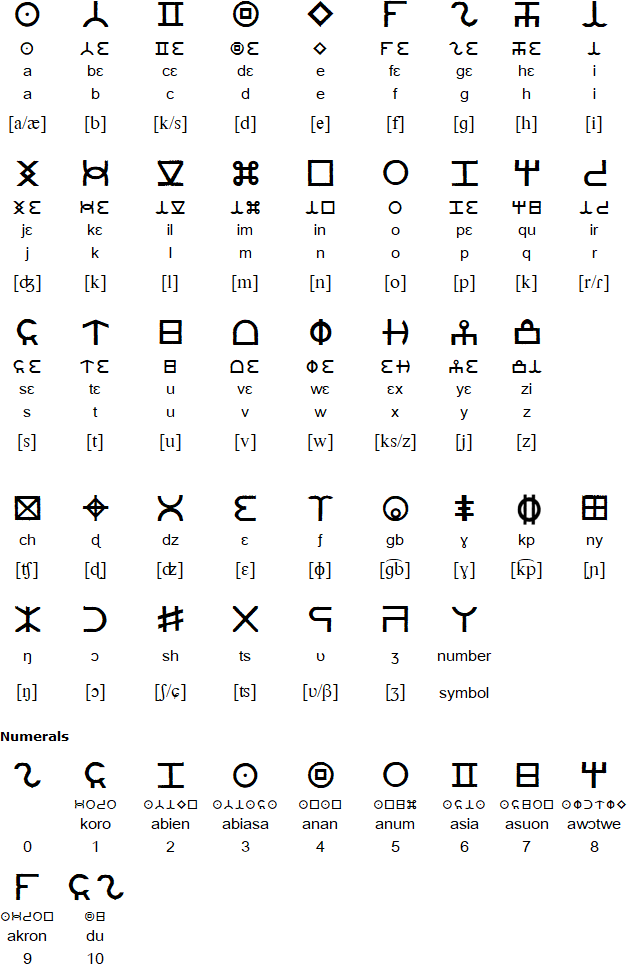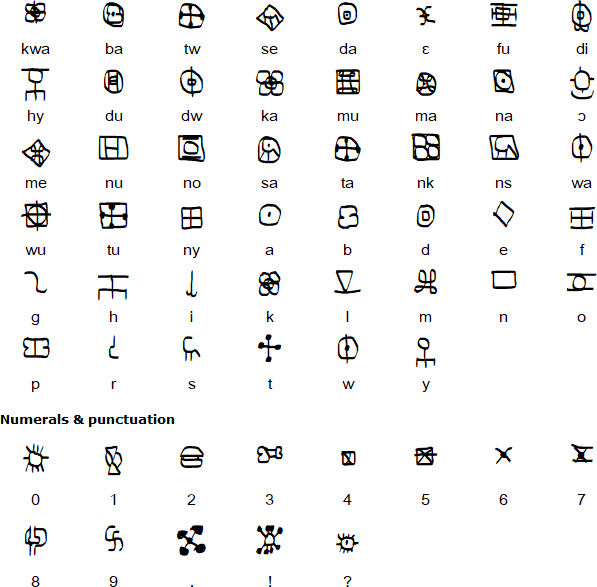The Adinkra alphabet is a way to write some of the languages spoken in Ghana and Ivory Coast, such as Akan, Dagbani, Ewe and Ga. It is a simplified version of the Adinkra symbols, and was introduced in 2015 by Charles M. Korankye, who has written a number of books about it.
According to tradition, the Adinkra symbols were created by Nana Kwadwo Agyemang Adinkra, the King Gyaman people in the Ashanti region of Ghana from 1810 to 1820. Or they were created by Gyaman people, and the king liked them so much that he wore them on his clothes and named that after himself.
The Adinkra symbols are used as decoration, logos, arts, sculpture, pottery and so on. The symbols represent sayings, proverbs or concepts, such as wisdom, authority, strength, unity, love adaptability, wealth, peace, war or agreement.

Download a font for Adinkra
Download a script chart for Adinkra (Excel)

Dua kontonkyikuronkyi na ɛma yehunu ɔdwomfo.
It is the unworkable (severely crooked) wood that shows us the (true) sculptor.
(Ghanaian proverb in Akan)
Sources: https://www.facebook.com/adinkraalphabet/posts/2827391340873315, https://www.adinkrasymbols.org/symbols/denkyem/
The Adinkra Syllabary is another was to write Asante Twi based on symbols used in Akan society since the early 19th century.

Download a font for Adinkra Nkyea
Download a script chart for the Adinkra Syllabary (Excel)
Information about the Adinkra Syllabary
https://en.wikipedia.org/wiki/Draft:Adinkra_Syllabary
Details of provided by Biswajit Mandal (biswajitmandal[dot]bm90[at]gmail[dot]com)
Information about the Adinkra alphabet and symbols
https://www.adinkraalphabet.com/
https://www.facebook.com/adinkraalphabet/
http://www.unicode.org/L2/L2021/21020-adinkra.pdf
https://en.wikipedia.org/wiki/Adinkra_symbols
https://www.adinkrasymbols.org/
https://www.endangeredalphabets.net/alphabets/adinkra/
https://breathlist.com/africa/ghana/culture-and-people/the-history-of-kente-and-adinkra-symbols/
http://www.adinkra.org/htmls/adinkra_index.htm
A-chik Tokbirim, Adinkra, ADLaM, Armenian, Avestan, Avoiuli, Bactrian, Bassa (Vah), Beitha Kukju, Beria (Zaghawa), Borama / Gadabuursi, Carian, Carpathian Basin Rovas, Chinuk pipa, Chisoi, Coorgi-Cox, Coptic, Cyrillic, Dalecarlian runes, Elbasan, Etruscan, Faliscan, Fox, Galik, Georgian (Asomtavruli), Georgian (Nuskhuri), Georgian (Mkhedruli), Glagolitic, Global Alphabet, Gothic, Greek, Hurûf-ı munfasıla, Irish (Uncial), Kaddare, Kayah Li, Khatt-i-Badí’, Khazarian Rovas, Koch, Korean, Latin, Lepontic, Luo Lakeside Script, Lycian, Lydian, Manchu, Mandaic, Mandombe, Marsiliana, Medefaidrin, Messapic, Mongolian, Mro, Mundari Bani, Nag Chiki, Naasioi Otomaung, N'Ko, North Picene, Novo Tupi, Nyiakeng Puachue Hmong, Odùduwà, Ogham, Old Church Slavonic, Oirat Clear Script, Ol Chiki (Ol Cemet' / Santali), Old Italic, Old Nubian, Old Permic, Ol Onal, Orkhon, Osage, Oscan, Osmanya (Somali), Pau Cin Hau, Phrygian, Pollard script, Runic, Székely-Hungarian Rovás (Hungarian Runes), South Picene, Sutton SignWriting, Sunuwar, Tai Viet, Tangsa, Todhri, Toto, Umbrian, (Old) Uyghur, Wancho, Yezidi, Zoulai
Page last modified: 15.03.23
[top]
You can support this site by Buying Me A Coffee, and if you like what you see on this page, you can use the buttons below to share it with people you know.

If you like this site and find it useful, you can support it by making a donation via PayPal or Patreon, or by contributing in other ways. Omniglot is how I make my living.
Note: all links on this site to Amazon.com, Amazon.co.uk
and Amazon.fr
are affiliate links. This means I earn a commission if you click on any of them and buy something. So by clicking on these links you can help to support this site.
[top]